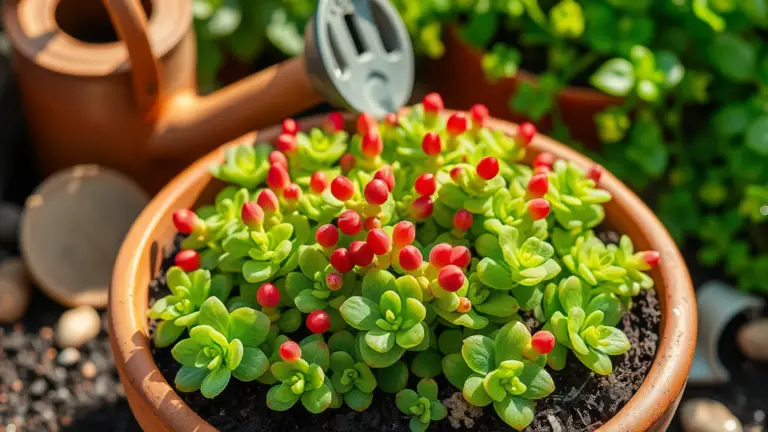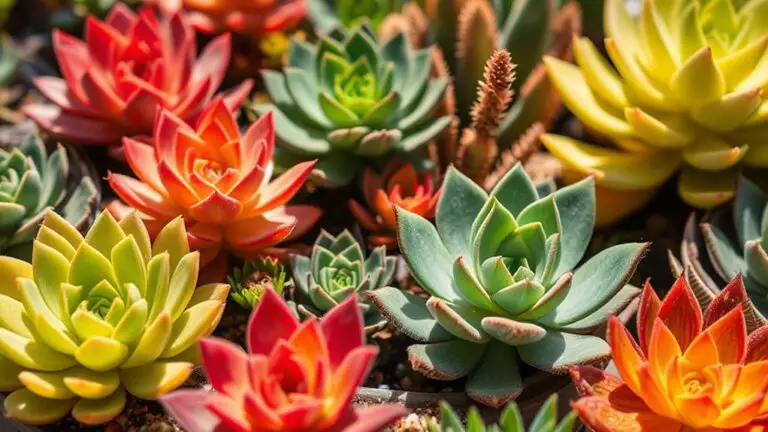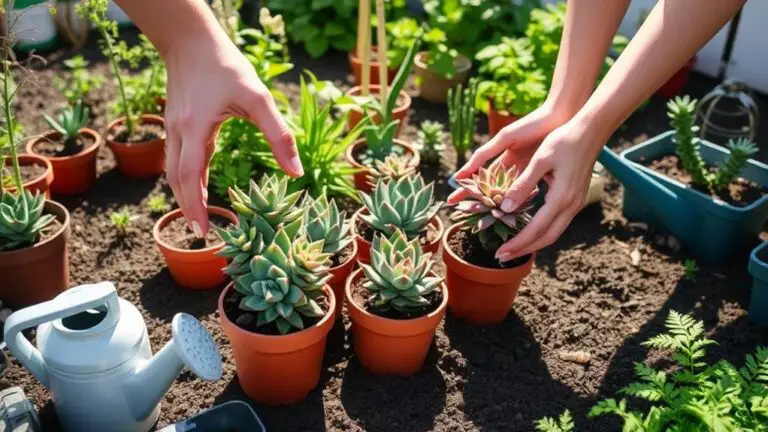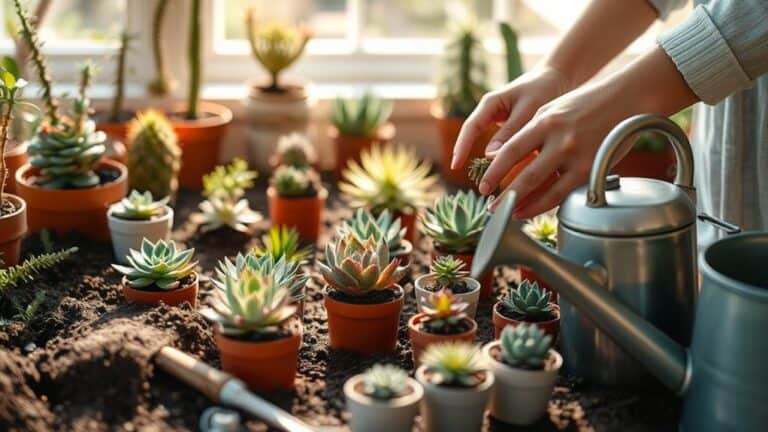How to Care for Echeveria Crinoline: Complete Guide
When you're caring for an Echeveria Crinoline, the first thing to focus on is its light requirements. You'll need to make certain it gets about six hours of bright, indirect sunlight each day. Placing it near an east-facing window often works best. But light is just the beginning. There's much more to take into account, from the type of soil you use to specific watering practices and even the right temperature range to maintain. So, how do you create the perfect environment for this succulent to thrive?
Light Requirements

Ensuring your Echeveria Crinoline gets the right amount of light is essential for its well-being. This succulent needs about six hours of bright, indirect sunlight each day to thrive. Finding the perfect spot in your home is key. An east-facing window is ideal because it offers gentle morning light.
If you prefer a south-facing window, make sure the plant is shielded from harsh afternoon sun to prevent leaf burn.
Low-light conditions won't work for your Echeveria Crinoline. Insufficient light can cause stunted growth and make the plant look leggy, which is far from ideal. You want to create an environment where it can grow compact and healthy.
Monitoring light exposure throughout the day is vital. While bright light is necessary, direct sunlight, especially in the afternoon, can damage the leaves. Keep an eye on your plant and adjust its placement if you notice any signs of leaf burn.
When your Echeveria Crinoline gets adequate light, it not only grows well but also shows off its vibrant colors. The pink margins on the leaves become more pronounced, adding to the plant's beauty.
With the right light, your plant will flourish, bringing joy and vibrant color to your space.
Soil Composition
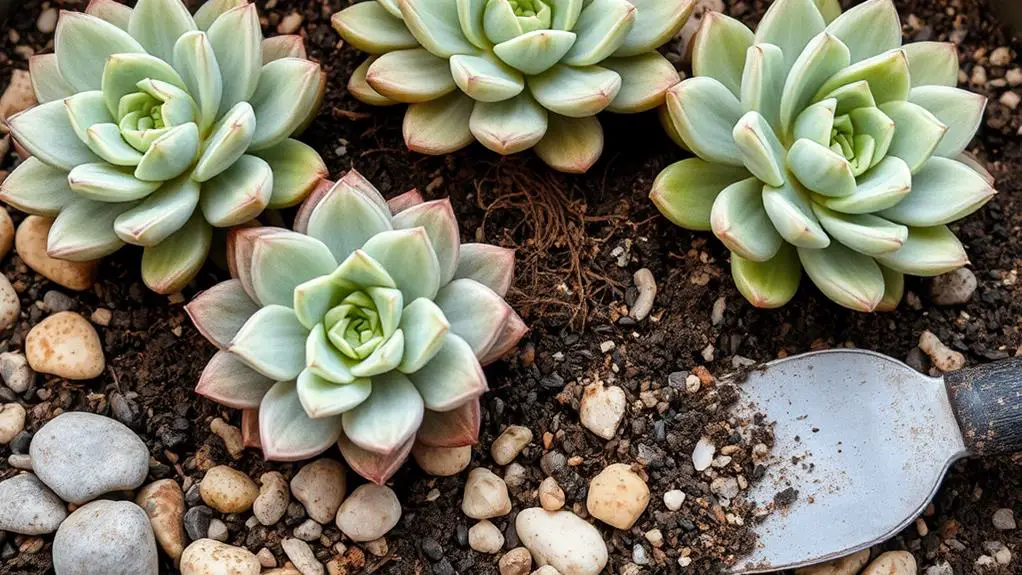
Now let's talk about the best soil for your Echeveria Crinoline.
This succulent loves well-draining soil, so a cactus mix from the garden store is a great start.
To make sure it stays happy, add some perlite or coarse sand to improve drainage and prevent root rot.
Ideal Soil Mix Components
Wondering how to create the perfect soil mix for your Echeveria Crinoline? It's easier than you might think! This succulent thrives in well-draining soil to prevent root rot.
You can start with a basic cactus mix, which is already designed to provide good drainage. However, to make it even better, you should add coarse sand and perlite or pumice.
By mixing equal parts cactus soil, perlite or pumice, and coarse sand, you create a soil blend that allows water to flow through easily, keeping roots healthy and dry. The coarse sand improves the soil's texture, ensuring it doesn't become compacted, which helps with drainage.
Adding peat moss can also be beneficial since it provides extra nutrients. But be careful: you don't want too much, as it can retain water and defeat the purpose of a well-draining mix.
Finally, regularly check the soil moisture. Make sure it dries out completely between waterings. This practice helps maintain the ideal conditions for your Echeveria Crinoline, preventing overwatering issues.
Follow these steps, and you'll have a thriving, happy plant in no time!
Enhancing Drainage Efficiency
Enhancing drainage efficiency in your Echeveria Crinoline's soil mix is vital for its overall health and growth. Start with a cactus mix from your local garden store. This mix is specially designed for succulents and cacti, ensuring good drainage.
But don't stop there; you can make it even better by adding perlite or coarse sand. These materials help increase airflow and prevent water from staying too long in the soil, which is essential for your plant's roots.
Adding peat moss to the soil mix is another smart move. It provides essential nutrients while maintaining a well-draining structure. This means your Echeveria Crinoline gets the food it needs without the risk of the soil getting too soggy.
Make sure your pot has drainage holes at the bottom. These holes let excess water escape, keeping the soil from becoming waterlogged.
It's also a good idea to regularly check the soil moisture. Make sure it dries out between waterings. Overly wet soil can harm your plant's health, so keeping an eye on moisture levels is key.
Preventing Root Rot
Guaranteeing proper drainage is just one part of the equation; preventing root rot requires careful attention to soil composition. To keep your Echeveria Crinoline healthy, it's crucial to use well-draining soil. This type of soil helps prevent water from sitting around the roots, which can cause root rot and other issues.
Here's how you can create the perfect soil mix for your plant:
- Choose a Cactus Mix: Go for a cactus mix from your local garden store. This type of soil is specifically designed to drain well and keep your plant's roots dry.
- Add Perlite or Coarse Sand: Enhance the drainage of your cactus mix by adding perlite or coarse sand. These materials help to prevent water retention and make sure your soil stays well-draining.
- Avoid Regular Potting Soil: Regular potting soil holds too much moisture and can lead to root rot. Stick to the specialized cactus mix to keep your Echeveria Crinoline happy.
Additionally, you can include a bit of peat moss to provide extra nutrients without compromising drainage.
Always check the soil moisture levels and guarantee your pot has drainage holes to let excess water escape. Following these steps will help you in preventing root rot and keeping your Echeveria Crinoline thriving.
Watering Practices

When it comes to watering your Echeveria Crinoline, less is more.
Make sure to water only when the soil is completely dry, which could mean about 0.5 cups every 12 days, depending on your environment.
Using a watering bottle or bottom-watering can help you avoid getting the leaves wet and prevent overwatering issues like root rot.
Proper Watering Techniques
Mastering proper watering techniques is essential for maintaining a healthy Echeveria Crinoline. This succulent thrives on minimal watering, so it's vital to avoid common pitfalls that lead to overwatering and root rot. Here's how to do it right!
- Use a watering bottle: A watering bottle helps direct the water straight to the soil without splashing onto the leaves. Wet leaves can rot, which you want to avoid at all costs.
- Keep the soil consistently dry: Only water your Echeveria Crinoline when the soil is completely dry. On average, this means about 0.5 cups of water every 12 days. However, you might need to adjust based on your local climate and season.
- Ensure proper drainage: After watering, always make sure excess water drains out completely. This prevents moisture from building up at the bottom of the pot, which can damage the roots.
Preventing Overwatering Issues
To keep your Echeveria Crinoline thriving, addressing overwatering issues is just as important as knowing when to water. Echeverias are succulents that store water in their leaves, so they don't need frequent watering. You should only water your plant when the soil is completely dry, typically every 12 days with about 0.5 cups of water.
Using a watering bottle or the bottom-watering method helps guarantee the water reaches the roots without wetting the leaves, which can cause rot. Always make certain that excess water drains completely from the pot. Echeveria Crinoline requires well-draining soil to avoid overwatering issues like yellowing or drooping leaves, which may lead to root rot.
Monitor soil moisture regularly, especially during winter dormancy, when the plant's water needs decrease considerably. Adjust your watering frequency accordingly.
Here's a quick reference table:
| Key Points | Practices |
|---|---|
| Watering Frequency | Every 12 days |
| Amount of Water | About 0.5 cups |
| Watering Method | Watering bottle or bottom-watering |
| Soil Condition | Completely dry before watering |
| Excess Water | Guarantee complete drainage |
| Watch for Overwatering | Yellowing or drooping leaves |
| Seasonal Adjustment | Less water during winter dormancy |
| Sunlight Needs | Bright sunlight for healthy growth |
Temperature and Humidity
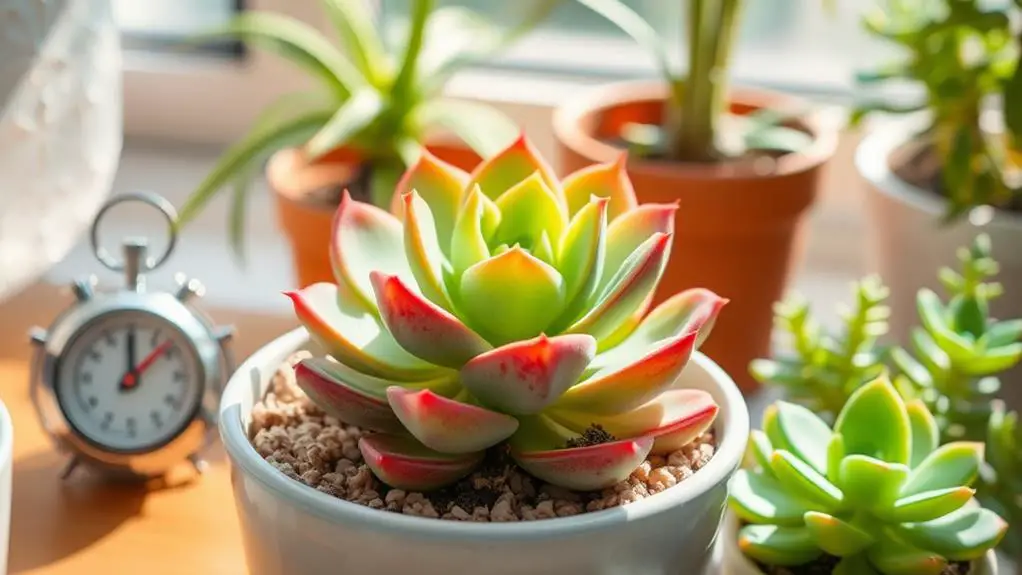
Echeveria Crinoline thrives in indoor temperatures between 65 and 85 degrees Fahrenheit, making it a perfect fit for most home environments.
This succulent loves warmth but can suffer if exposed to temperatures below 50 degrees Fahrenheit. To keep your Echeveria Crinoline healthy, it's crucial to monitor the temperature closely, especially during colder months.
Humidity is another critical factor. Echeveria Crinoline prefers low humidity levels, similar to its natural desert habitat. High humidity can lead to excess moisture, which may cause root rot.
It's a good idea to keep the plant in a well-ventilated area to avoid this problem. Regularly checking the temperature and humidity around your plant will help it thrive.
Here's a quick guide to guarantee you're on the right track:
- Monitor Temperature: Keep the indoor temperature between 65 and 85 degrees Fahrenheit.
- Avoid Cold: Make sure the temperature never drops below 50 degrees Fahrenheit.
- Control Humidity: Maintain low humidity levels to mimic the plant's natural environment.
Fertilization and Care
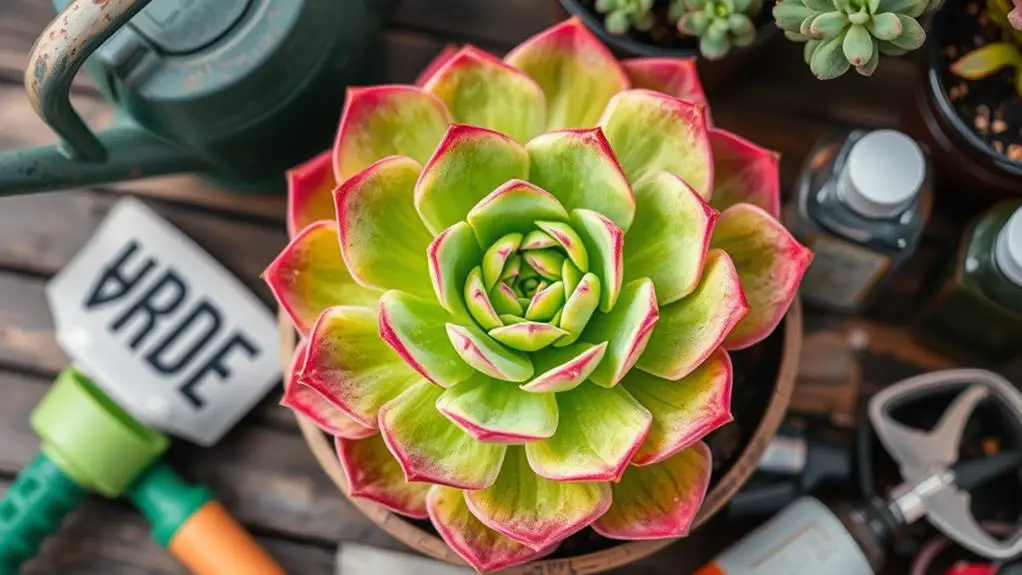
While maintaining the right temperature and humidity is essential for Echeveria Crinoline, providing proper fertilization and care can further enhance its growth and energy. Fertilization for these succulents is optional since they usually thrive on sunlight alone. However, if you decide to fertilize, use a water-soluble fertilizer at the beginning of the growing season to give your plant a boost.
When repotting your Echeveria Crinoline, which is best done in spring or summer, consider using fresh compost. This can supply extra nutrients to support your plant's health and reduce any transplant shock. Always choose a pot that's at least 10% larger than the previous one to allow room for growth.
Monitoring your plant for signs of nutrient deficiencies, such as yellowing or browning leaves, is essential. This will help you adjust your care practices effectively.
Here's a quick reference table to help you:
| Task | Recommendation |
|---|---|
| Fertilization | Optional; use water-soluble in spring |
| Repotting Season | Best in spring or summer |
| Pot Size | At least 10% larger than previous pot |
| Nutrient Deficiencies | Look for yellowing or browning leaves |
Propagation Methods

Propagating Echeveria Crinoline is a rewarding way to expand your succulent collection or share plants with friends. There are three main methods to propagate these beautiful plants: leaf cuttings, offsets, and seeds. Here's how you can do it:
1. Leaf Cuttings: Select a healthy leaf from the main plant. Gently twist it off, ensuring you get the entire leaf. Let it callus for a few days in a dry area.
Once dry, plant the leaf in well-draining soil. Water sparingly and keep it in indirect light until roots form.
2. Offsets: Echeveria Crinoline often produces small offsets, or "chicks," around the base. Carefully separate these offsets from the main plant.
Let them dry for a day or two before planting them in soil. Like leaf cuttings, water them sparingly and provide indirect light to help them establish.
3. Seeds: If you prefer seed propagation, sow seeds in well-draining soil.
Keep the soil moist and place it in a bright area to encourage germination. This method requires patience but can be very satisfying.
Common Issues
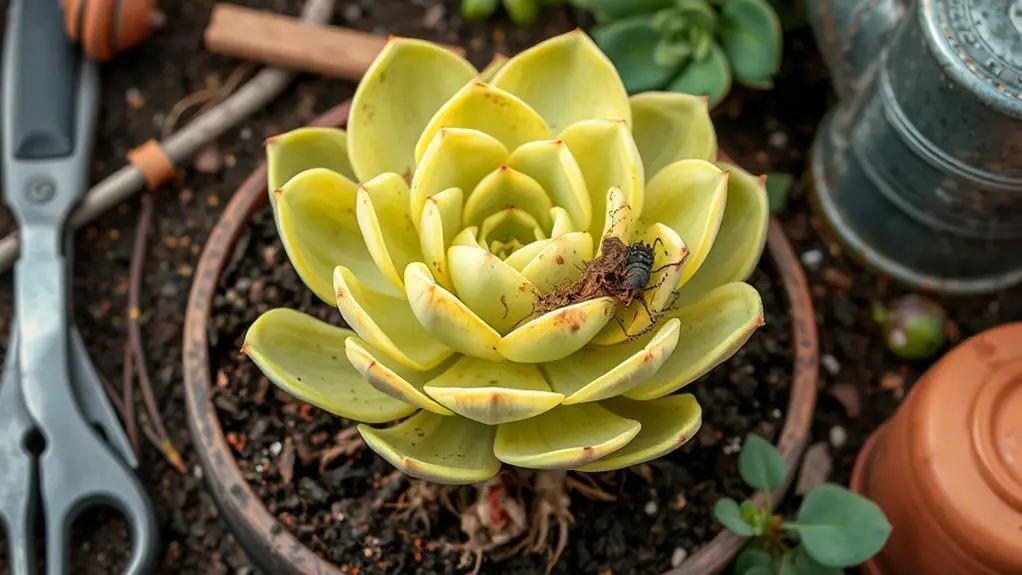
Caring for Echeveria Crinoline can be straightforward, but like any plant, it has its share of common issues. One frequent problem is leaf discoloration. Yellowing leaves might mean you're overwatering or the plant lacks nutrients. Browning edges often suggest it's not getting enough light or water. To fix this, adjust your watering routine and guarantee it gets plenty of sunlight.
Root rot is another issue you might face. It happens when there's too much moisture in the soil, making the roots mushy and dark. To prevent root rot, let the soil dry out between waterings and use well-draining soil. If you already see signs of root rot, repot the plant immediately.
Sometimes, Echeveria Crinoline can become leggy, growing tall and sparse due to insufficient light. If this happens, move your plant closer to a bright window. Also, keep an eye out for pests like mealybugs and aphids. Regular inspections and using insecticidal soap can help keep these pests at bay.
Here's a quick summary of these common issues:
| Issue | Solution |
|---|---|
| Leaf Discoloration | Adjust watering, check light levels |
| Root Rot | Let soil dry, use well-draining soil |
| Legginess | Move to a brighter location |
Flowering and Blooming
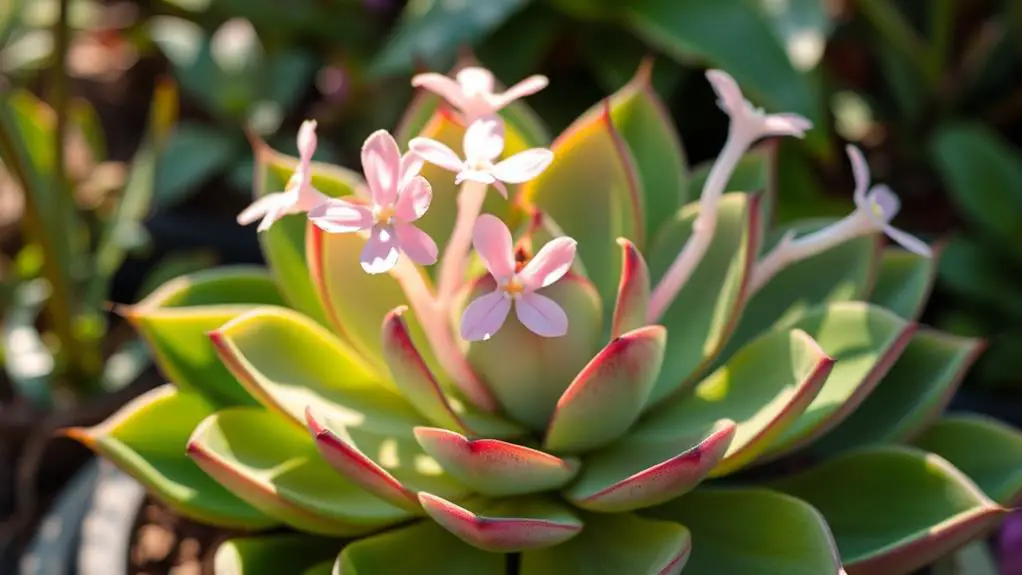
Addressing common issues with Echeveria Crinoline sets the stage for robust growth and a thriving plant.
Now, let's talk about flowering and blooming. Echeveria Crinoline produces stunning bell-shaped flowers in shades of pink, coral, and orange. These blooms typically appear in the spring and summer, lasting several weeks. They grow on stalks that emerge from the rosettes, adding to the plant's unique beauty.
To encourage blooming, make certain your Echeveria gets plenty of bright sunlight. This not only enhances the chances of blooming but also makes the flower colors more vibrant.
Here are some practical tips to help your Echeveria Crinoline bloom successfully:
- Provide Adequate Sunlight: Place your plant where it can receive bright, indirect light for most of the day.
- Water Properly: Water the plant when the soil is completely dry to avoid overwatering, which can hinder blooming.
- Use Well-Draining Soil: Confirm the soil mix drains well to promote healthy roots and blooming.
Toxicity and Safety
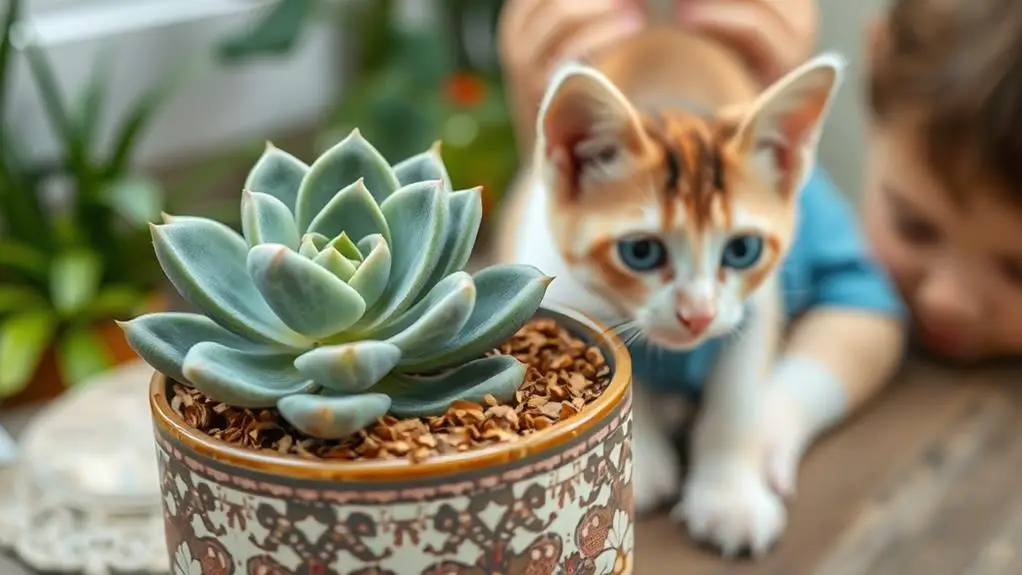
When considering the safety of your home environment, Echeveria Crinoline Ruffles is a fantastic choice. This beautiful succulent is non-toxic to cats, dogs, and humans, making it safe for households with pets and children.
You can enjoy the plant's unique ruffled leaves without worrying about any harmful effects if a curious pet or child decides to explore it a bit too closely. The non-toxic nature of Echeveria Crinoline Ruffles gives you peace of mind, allowing you to appreciate its beauty without concerns about ingestion or adverse reactions.
However, it's still wise to discourage pets from chewing on the plant. While it's generally safe, some pets might experience sensitivity if they chew on its leaves too much.
It's always a good idea to monitor your pets and children around any plant, as individual sensitivities can vary. If anyone in your home has known allergies, keep an eye out for any unusual reactions, just to be safe.
Frequently Asked Questions
How Do You Care for Potted Echeveria?
Place your potted echeveria in bright, indirect sunlight for about six hours daily. Water sparingly, ensuring the soil is dry before re-watering. Use well-draining soil, avoid temperatures below 50°F, and fertilize optionally during the growing season.
How Do You Keep Echeveria Happy?
To keep your Echeveria happy, give it bright, indirect sunlight for about six hours daily, water only when the soil is dry, use well-draining soil, maintain temperatures between 65-85°F, and optionally fertilize at the growing season's start.
How Often Should Echeveria Be Watered?
You should water your Echeveria every 12 days with about 0.5 cups of water. Confirm the soil is completely dry before watering again to prevent root rot. During winter dormancy, reduce watering frequency as the plant needs less moisture.
How Much Sunlight Does Echeveria Need?
Echeveria needs around six hours of bright, indirect sunlight daily. Place it near east-facing windows for morning light. Avoid direct afternoon sunlight to prevent leaf burn. South-facing windows work if you keep it out of direct rays.
Conclusion
You've got this! Caring for your Echeveria Crinoline is all about giving it the right light, soil, and water. Remember to keep it in bright, indirect sunlight and let the soil dry out before watering. Keep an eye on the temperature and check for pests regularly. With a bit of attention and love, your plant will thrive. Just follow these steps, and you'll enjoy a beautiful, healthy Echeveria Crinoline in no time!


